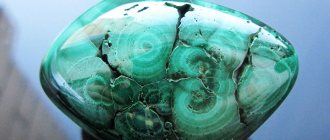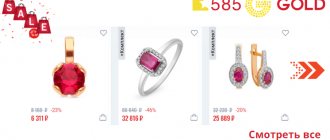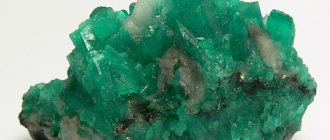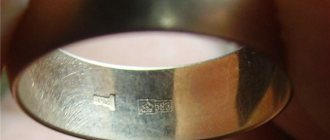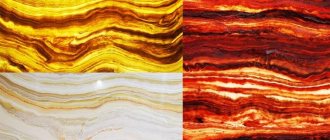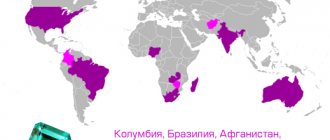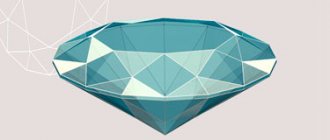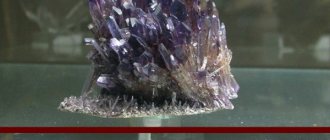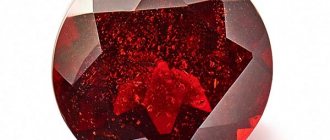Inside the sections you will see lists of stones that relate to it. If it seems to you that the stone you found is similar to one whose name you know, then you can use the search form and compare the results with the find. If you do not assign names at all, then you will need to determine the exact name of your stone from its photograph.
Each mineral can be opened and you can see its enlarged photo along with a detailed description.
This may be useful: Identify a plant from a photo online.
An application that will help you determine the name of a mineral
Some stones are classified as minerals, so this application will also help you find the name of the stone. This encyclopedia is not inferior in completeness to the database described above, but surpasses it in functionality.
So, its functions are as follows:
- Search form.
- Ability to mark minerals as favorites.
- Different sorting directions.
- List filter.
- The ability to remove any minerals from the list, as well as add your own.
- Several high-quality photos in mineral cards that will help you identify the stone, as well as detailed descriptions, including chemical composition, properties, uses and more.
- It is possible to share the mineral on social networks or messenger.
- The app is free, but there are some ads.
- Russian language is available.
One drawback should be highlighted - the application seems unfinished, since there are non-working buttons, clicking on which will not lead to anything, and sometimes it can take too long. However, despite this, this encyclopedia has a large number of fans and many good reviews.
The application can be downloaded on Android from Google Play using this link. After installation, you can launch it and immediately see a list of minerals with small photos, and list controls - a search form, a button for sorting and filtering.
You can search for your stone using a photo, comparing it with the image in the list. You can enlarge each photo by touching one or another item on the list. There you can also see a more detailed description and more images.
If you have at least an approximate idea of the name of the stone you found, then you can try searching for it in the search form by name. If you can attribute your find to any type, then a filter will help you, which will allow you to divide the list by type of minerals.
By clicking on the plus icon at the bottom right, you can add your mineral. To do this, click on the green button in the menu that opens.
If you click on the red one, you can edit or remove any mineral from the list.
You may be interested in: Identify an object from a photo.
Aventurine
Most often, aventurine glass is sold under the guise of natural aventurine - an imitation of quartzite, which is obtained by adding copper and iron oxides (red-brown “aventurine”), chromium oxides (green), and cobalt oxides (blue) to the molten glass mass. An excessive amount of glitter usually indicates imitation. In glass imitation, the scales can sometimes be unevenly distributed, and zones of colored glass with a reduced glitter content or without them at all can be observed.
The color of natural stone is white, light gray, honey, pink, brick, cherry, green. Saturated colors are not uncommon, but sparkles in natural aventurine are rare. Aventurine glass has an excessive amount of shiny inclusions; in natural aventurine this shiny pollen is not so pronounced.
On the left is a glass fake, on the right is natural aventurine
Yandex intelligent search for identifying stones from photos
In order to determine the name of a stone from an image, you can use the algorithms of the Yandex search engine. And unlike the methods described above, here you do not have to compare the stone with photo samples yourself. The search engine will do this for you. But, as with any machine, there is a small chance of error and inaccuracy.
In order to recognize a stone from a photo, you will need a smartphone or tablet running Android or iOS.
The procedure for determining the name of a gemstone from a photograph:
- Download the Yandex application with Alice and install it on your device - links for Android and iOS. Open it and you will see the main page. Then you can go in two ways - search in the Yandex image search or search together with Alice.
- To search by image, in the search form, click on the camera icon.
- The camera will open. Point the lens at the stone whose name you want to know and take a photo by pressing the yellow button. Or upload a photo from your device gallery using the button at the bottom right. The photo should be in good light, and preferably there should be no other objects in it.
- After uploading the photo, Yandex will find similar images and from them you will understand what kind of stone is in front of you.
- To search using Alice, click on her icon in the bottom center.
- Click on the camera icon.
- Take a photo of the mineral using the camera that opens, or upload an image from the gallery. Also try to take the highest quality photo possible.
- As a result, Alice will voice the result of the analysis and name the name of the stone, as well as provide useful links to it.
Volcanic or cherry quartz
Another glass posing as quartz is pink glass with streaks, which unscrupulous sellers call “cherry quartz.” What you should pay attention to is the hardness (quartz is very difficult to scratch), the unnatural color of the product in fakes indicates its synthetic origin and imitation. If we assume that you bought natural quartz, then the cleavage lines will be clearly visible in it, and paint can be seen in internal inclusions and microcracks, since it is often tinted to make it more saturated. Also, natural quartz will be heavier. Good glass imitations are sometimes made very realistic, but high transparency and unnatural hairy inclusions with air bubbles will always be a sign of a fake.
On the left is glass “Cherry quartz” and on the right is natural quartz with inclusions, which it imitates
Glass “volcanic quartz” has a characteristic hairiness designed to imitate inclusions of hematite and lepidocrocite in natural stone; the shade of such glass is always the same, but of different saturation with different degrees of dilution of dyes. In addition to pink shades, this glass is also made with brown and yellow stains, and the main difference will be the presence of air bubbles in the beads and cabochons.
Fakes "Volcanic quartz"
Google lens - easily determine the name of the mineral from a photograph
Google lens or Google lens is an application similar to the one described above. It can search by uploaded photos, just like Yandex and Alice, but much simpler and easier.
What should be done:
- You can download the Android version from this link https://play.google.com/store/apps/details?id=com.google.ar.lens&hl=ru. Install and launch the application.
- The camera will open immediately. Point it at the stone and take a photo by clicking on the button at the bottom of the screen. Or download using the appropriate button on the left. In this case, you must be in the “Search” tab.
- As a result, you will receive similar images and descriptions for them, from which you will be able to understand the name of your stone from the picture.
The applications described above solve the problem in different ways: the first two are an updated interactive encyclopedia - they are more suitable for professionals who have at least some understanding of geology; and the last two are simpler and more convenient for amateurs, however, under some circumstances, for example, with a low-quality photo, they can give inaccurate results.
cat's eye
Colored cat's eye beads with even stripes are, of course, also fake. The true mineral chrysoberyl is incredibly rare and expensive, but if its visual properties are what attracts you, then there are other stones that have this visual effect - for example, quartz cat's eye. True, natural stones never have bright open colors: natural chrysoberyl has a gray-olive color scheme, and quartz cat's eye has a gray color. Therefore, there is no alternative to glass borosilicate beads with a “cat’s eye effect” in terms of variety of colors.
On the left is a quartz cat's eye, on the right is a glass imitation cat's eye
How to distinguish a real stone from a fake
Often, determining the material and origin of a jewelry insert is difficult due to setting, and then it is necessary to use a set of available determination methods, both direct - determining the diagnostic constants of minerals, and indirect - allowing one to judge the mineral type indirectly.
Diagnosis of a mineral species in the simplest case is carried out on the basis of measured optical-structural constants of minerals, but subject to limited access (including for visual inspection), additional methods are used, such as:
- thermal conductivity research;
- electrical conductivity study;
- study of magnetic properties;
- study of the nature of various types of luminescence.
In minerals partially accessible to visual observation, the following methods are used:
- study of the appearance of internal microinclusions;
- examination of the surface (its defects and individual characteristics);
- study of the nature of pleochroism;
- study of the nature of birefringence;
- investigation of internal structural anomalies.
When determining organic jewelry stones and diamond, in addition to measuring optical constants, Raman and luminescence spectroscopy, the infrared spectroscopy method is used to identify characteristic carbon-containing compounds.
Video: How to check a diamond at home?
It is quite difficult to distinguish a natural amethyst from a fake one. They are so similar in appearance and characteristics that it is very easy to be misled and purchase a fake. And there is only one property of natural amethyst that cannot be faked: it takes a very long time to heat up, while even the highest quality copies heat up many times faster. Using the same principle, you can distinguish rock crystal .
Turquoise is counterfeited with plastic, low quality turquoise, enamel and cheap minerals. It is difficult to distinguish the original from the fake. Only time will help reveal the falsity: after a few years, fake turquoise will darken and become covered with ugly grayish-dirty spots.
Turquoise
Natural garnet can be easily identified with a regular magnet. Since this stone is magnetic, it is enough to place it on a metal pan of scales, having previously provided a non-magnetic layer between the garnet and the bowl, and move a magnet over it. The weight of the stone will be less, because it will react to the attraction of the magnet. Another distinctive feature of natural pomegranate is its size – no larger than a pomegranate grain.
Sometimes one glance at a stone is enough to understand that this is a fake. If air bubbles are visible in the so-called garnet in the light, the stone need not be subjected to further testing, because it is an obvious fake. But heterogeneity of color and small inclusions, on the contrary, indicate the authenticity of the mineral.
Natural aquamarine is easy to distinguish from a fake. To do this, you need to look at the stone from different angles. If the mineral is natural, it will slightly change shade at a new angle, but if it is fake, the color will remain the same. Aquamarine is counterfeited with glass, artificial spinel and quartz.
Natural aquamarine
To distinguish natural pearls from fakes, experts advise trying the stone “by tooth.” If the pearls are natural, a salty sea taste will remain in your mouth, and small grains of sand will remain on your teeth. Sellers of counterfeits are aware of this feature of pearls, so they will probably object to such experiments.
